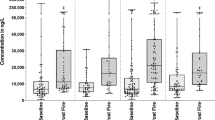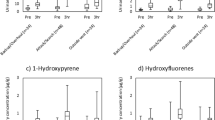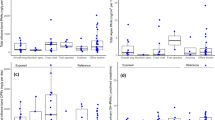Abstract
Wildland firefighter’s exposure to wildland fire or vegetative biomass smoke has mostly been assessed by personal monitoring to airborne pollutants. However, the use of biomarkers may accurately reflect the internal (systemic) dose received by the firefighter. In this study, we assessed occupational exposure to wildland fire smoke in 14 wildland firefighters working at prescribed burns at the Savannah River Site, South Carolina by measuring the urinary concentrations of nine hydroxylated metabolites of polycyclic aromatic hydrocarbons (OH-PAHs). Except for 1-hydroxynaphthalene, preshift median concentrations of the OH-PAHs were higher compared with the median concentrations reported among the US general population, indicating elevated exposures to PAHs among the wildland firefighters during the prescribed burn season. The postshift concentrations of OH-PAHs were 83–323% (P<0.0001) higher compared with the preshift concentrations. Higher postshift concentrations of individual OH-PAHs were observed in 49 (87.5%) to 53 (94.6%) of all the 56 pre–post sample pairs. Additionally, the cross-shift (pre- to postshift) increase in 4-hydroxy-phenanthrene urinary concentration was marginally associated (P<0.1) with work shift exposure to PM2.5 and significantly associated (P<0.05) with levoglucosan, which is a marker of wildland fire or vegetative biomass smoke. These results suggest that OH-PAHs, especially 4PHE, may be useful biomarkers of wildland fire smoke exposure.
This is a preview of subscription content, access via your institution
Access options
Subscribe to this journal
Receive 6 print issues and online access
$259.00 per year
only $43.17 per issue
Buy this article
- Purchase on Springer Link
- Instant access to full article PDF
Prices may be subject to local taxes which are calculated during checkout



Similar content being viewed by others
References
Kodgule R, Salvi S . Exposure to biomass smoke as a cause for airway disease in women and children. Curr Opin Allergy Clin Immunol 2012; 12: 82–90.
Bari MA, Baumbach G, Kuch B, Scheffknecht G . Temporal variation and impact of wood smoke pollution on a residential area in southern Germany. Atmos Environ 2010; 44: 3823–3832.
Favez O, Cachier H, Sciare J, Sarda-Estève R, Martinon L . Evidence for a significant contribution of wood burning aerosols to PM2.5 during the winter season in Paris, France. Atmos Environ 2009; 43: 3640–3644.
Gorin CA, Collett JL, Jr, Herckes P . Wood smoke contribution to winter aerosol in Fresno, CA. J Air Waste Manag Assoc 2006; 56: 1584–1590.
Jeong C-H, Evans GJ, Dann T, Graham M, Herod D, Dabek-Zlotorzynska E et al. Influence of biomass burning on wintertime fine particulate matter: source contribution at a valley site in rural British Columbia. Atmos Environ 2008; 42: 3684–3699.
Kim E, Hopke PK . Source characterization of ambient fine particles at multiple sites in the Seattle area. Atmos Environ 2008; 42: 6047–6056.
Szidat S, Prévôt AS, Sandradewi J, Alfarra MR, Synal HA, Wacker L et al. Dominant impact of residential wood burning on particulate matter in Alpine valleys during winter. Geophys Res Lett 2007; 34: L05820.
Wang H, Kawamura K, Shooter D . Wintertime organic aerosols in Christchurch and Auckland, New Zealand: contributions of residential wood and coal burning and petroleum utilization. Environ Sci Technol 2006; 40: 5257–5262.
Wu J, M Winer A, Delfino R J . Exposure assessment of particulate matter air pollution before, during, and after the 2003 Southern California wildfires. Atmos Environ 2006; 40: 3333–3348.
Mott JA, Meyer P, Mannino D, Redd SC, Smith EM, Gotway-Crawford C et al. Wildland forest fire smoke: health effects and intervention evaluation, Hoopa, California, 1999. West J Med 2002; 176: 157.
Reinhardt TE, Ottmar RD . Baseline measurements of smoke exposure among wildland firefighters. J Occup Environ Hyg 2004; 1: 593–606.
Adetona O, Dunn K, Hall DB, Achtemeier G, Stock A, Naeher LP . Personal PM2. 5 exposure among wildland firefighters working at prescribed forest burns in southeastern United States. J Occup Environ Hyg 2011; 8: 503–511.
Adetona O, Simpson CD, Onstad G, Naeher LP . Exposure of wildland firefighters to carbon monoxide, fine particles, and levoglucosan. Ann Occup Hyg 2013; 57: 979–991.
Reisen F, Brown SK . Australian firefighters' exposure to air toxics during bushfire burns of autumn 2005 and 2006. Environ Int 2009; 35: 342–352.
Miranda AI, Martins V, Cascão P, Amorim JH, Valente J, Tavares R et al. Monitoring of firefighters exposure to smoke during fire experiments in Portugal. Environ Int 2010; 36: 736–745.
Johnston FH, Bailie RS, Pilotto LS, Hanigan IC . Ambient biomass smoke and cardio-respiratory hospital admissions in Darwin, Australia. BMC Public Health 2007; 7: 240.
Morgan G, Sheppeard V, Khalaj B, Ayyar A, Lincoln D, Jalaludin B et al. Effects of bushfire smoke on daily mortality and hospital admissions in Sydney, Australia. Epidemiology 2010; 21: 47–55.
Delfino RJ, Brummel S, Wu J, Stern H, Ostro B, Lipsett M et al. The relationship of respiratory and cardiovascular hospital admissions to the southern California wildfires of 2003. Occup Environ Med 2008; 66: 189–197.
Naeher LP, Brauer M, Lipsett M, Zelikoff JT, Simpson CD, Koenig JQ et al. Woodsmoke health effects: A review. Inhal Toxicol 2007; 19: 67–106.
Neitzel R, Naeher L, Paulsen M, Dunn K, Stock A, Simpson C . Biological monitoring of smoke exposure among wildland firefighters: a pilot study comparing urinary methoxyphenols with personal exposures to carbon monoxide, particular matter, and levoglucosan. J Expo Sci Environ Epidemiol 2008; 19: 349–358.
Hinwood AL, Trout M, Murby J, Barton C, Symons B . Assessing urinary levoglucosan and methoxyphenols as biomarkers for use in woodsmoke exposure studies. Sci Total Environ 2008; 402: 139–146.
Naeher LP, Barr DB, Adetona O, Simpson CD . Urinary levoglucosan as a biomarker for woodsmoke exposure in wildland firefighters. Int J Occup Environ Health 2013; 19: 304–310.
Dunn KH, Devaux I, Stock A, Naeher LP . Application of end-exhaled breath monitoring to assess carbon monoxide exposures of wildland firefighters at prescribed burns. Inhal Toxicol 2009; 21: 55–61.
Gustafson P, Östman C, Sällsten G . Indoor levels of polycyclic aromatic hydrocarbons in homes with or without wood burning for heating. Environ Sci Technol 2008; 42: 5074–5080.
Bari MA, Baumbach G, Brodbeck J, Struschka M, Kuch B, Dreher W et al. Characterisation of particulates and carcinogenic polycyclic aromatic hydrocarbons in wintertime wood-fired heating in residential areas. Atmos Environ 2011; 45: 7627–7634.
Ward TJ, Palmer CP, Houck JE, Navidi WC, Geinitz S, Noonan CW . Community woodstove changeout and impact on ambient concentrations of polycyclic aromatic hydrocarbons and phenolics. Environ Sci Technol 2009; 43: 5345–5350.
Poulain L, Iinuma Y, Müller K, Birmili W, Weinhold K, Brüggemann E et al. Diurnal variations of ambient particulate wood burning emissions and their contribution to the concentration of polycyclic aromatic hydrocarbons (PAHs) in Seiffen, Germany. Atmos Chem Phys 2011; 11: 12 697–12 713.
Kocbach A, Namork E, Schwarze PE . Pro-inflammatory potential of wood smoke and traffic-derived particles in a monocytic cell line. Toxicology 2008; 247: 123–132.
Danielsen PH, Loft S, Jacobsen NR, Jensen KA, Autrup H, Ravanat J-L et al. Oxidative stress, inflammation and DNA damage in rats after intratracheal instillation or oral exposure to ambient air and wood smoke particulate matter. Toxicol Sci 2010; 118: 574–585.
Danielsen PH, Møller P, Jensen KA, Sharma AK, Wallin Hk, Bossi R et al. Oxidative stress, DNA damage, and inflammation induced by ambient air and wood smoke particulate matter in human A549 and THP-1 cell lines. Chem Res Toxicol 2011; 24: 168–184.
Li Z, Sjödin A, Romanoff LC, Horton K, Fitzgerald CL, Eppler A et al. Evaluation of exposure reduction to indoor air pollution in stove intervention projects in Peru by urinary biomonitoring of polycyclic aromatic hydrocarbon metabolites. Environ Int 2011; 37: 1157–1163.
Adetona O, Li Z, Sjödin A, Romanoff LC, Aguilar-Villalobos M, Needham LL et al. Biomonitoring of polycyclic aromatic hydrocarbon exposure in pregnant women in Trujillo, Peru — Comparison of different fuel types used for cooking. Environ Int 2013; 53: 1–8.
Riojas-Rodriguez H, Schilmann A, Marron-Mares AT, Masera O, Li Z, Romanoff L et al. Impact of the improved patsari biomass stove on urinary polycyclic aromatic hydrocarbon biomarkers and carbon monoxide exposures in rural Mexican women. Environ Health Perspect 2011; 119: 1301–1307.
Torres-Dosal A, Pérez-Maldonado IN, Jasso-Pineda Y, Martínez Salinas RI, Alegría-Torres JA, Díaz-Barriga F . Indoor air pollution in a Mexican indigenous community: evaluation of risk reduction program using biomarkers of exposure and effect. Sci Total Environ 2008; 390: 362–368.
USFS. USDA Forest Service Savannah River: Fire Management. Available at: www.fs.usda.gov/detail/savannahriver/home/?cid=stelprdb5177299 (last accessed 7 August 2013).
Meng L, Kato K, Li Z, Trinidad D, Hubbard K, Pittman E et al Determination of monohydroxy polycyclic aromatic hydrocarbons in urine using on-line solid phase extraction-high performance liquid chromatography-isotope dilution tandem mass spectrometry. Presented (P-T-1206) at HPLC 2014 (11–15 May 2014; New Orleans, LA, USA), 2014.
Hornung R, Reed L . Estimation of average concentration in the presence of nondetectable values. Appl Occup Environ Hyg 1990; 5: 46–51.
Kim Oanh NT, Reutergårdh LB, Dung NT . Emission of polycyclic aromatic hydrocarbons and particulate matter from domestic combustion of selected fuels. Environ Sci Technol 1999; 33: 2703–2709.
Kim Oanh NT, Nghiem LH, Phyu YL . Emission of polycyclic aromatic hydrocarbons, toxicity, and mutagenicity from domestic cooking using sawdust briquettes, wood, and kerosene. Environ Sci Technol 2002; 36: 833–839.
Xu S, Liu W, Tao S . Emission of polycyclic aromatic hydrocarbons in China. Environ Sci Technol 2006; 40: 702–708.
Ravindra K, Sokhi R, Van Grieken R . Atmospheric polycyclic aromatic hydrocarbons: source attribution, emission factors and regulation. Atmos Environ 2008; 42: 2895–2921.
Forchhammer L, Loft S, Roursgaard M, Cao Y, Riddervold IS, Sigsgaard T et al. Expression of adhesion molecules, monocyte interactions and oxidative stress in human endothelial cells exposed to wood smoke and diesel exhaust particulate matter. Toxicol Lett 2012; 209: 121–128.
Kocbach A, Li Y, Yttri KE, Cassee FR, Schwarze PE, Namork E . Physicochemical characterisation of combustion particles from vehicle exhaust and residential wood smoke. Part Fibre Toxicol 2006; 3: 1.
Kato M, Loomis D, Brooks LM, Gattas GF, Gomes L, Carvalho AB et al. Urinary biomarkers in charcoal workers exposed to wood smoke in Bahia State, Brazil. Cancer Epidemiol Biomarkers Prev 2004; 13: 1005–1012.
Li Z, Sandau CD, Romanoff LC, Caudill SP, Sjodin A, Needham LL et al. Concentration and profile of 22 urinary polycyclic aromatic hydrocarbon metabolites in the US population. Environ Res 2008; 107: 320–331.
CDC. . Fourth National Report on Human Exposure to Environmental Chemicals: Updated Tables. Centers for Disease Control and Prevention, Services DoHaH: Atlanta, GA, USA. 2015.
Li Z, Trinidad D, Pittman EN, Riley EA, Sjodin A, Dills RL et al. Urinary polycyclic aromatic hydrocarbon metabolites as biomarkers to woodsmoke exposure — results from a controlled study. J Expo Sci Environ Epidemiol 2015 (doi:10.1038/jes.2014.94).
Acknowledgements
We gratefully acknowledge John Blake for support and collaboration in our wildland fire smoke related exposure research; Jeff Prevey, Paul Linse, Mark Frizzel, Dan Shea, Chris Hobson and the wildland firefighters for their support and participation in this study. This research was conducted at the SRS, which is a National Environmental Research Park. Funding of the study was through the National Institute of Occupational Safety and Health (OH 009274).
Disclaimer
The findings and conclusions in this report are those of the authors and do not necessarily represent the views of the Centers for Disease Control and Prevention (CDC). The use of trade names and commercial sources is for identification only and does not constitute endorsement by the US Department of Health and Human Services or CDC.
Author information
Authors and Affiliations
Corresponding author
Ethics declarations
Competing interests
The authors declare no conflict of interest.
Rights and permissions
About this article
Cite this article
Adetona, O., Simpson, C., Li, Z. et al. Hydroxylated polycyclic aromatic hydrocarbons as biomarkers of exposure to wood smoke in wildland firefighters. J Expo Sci Environ Epidemiol 27, 78–83 (2017). https://doi.org/10.1038/jes.2015.75
Received:
Revised:
Accepted:
Published:
Issue Date:
DOI: https://doi.org/10.1038/jes.2015.75
Keywords
This article is cited by
-
Environmental health of wildland firefighters: a scoping review
Fire Ecology (2024)
-
A Simultaneous Determination of Benzophenone and Camphor UV-Filters, Together with Metabolites of Polycyclic Aromatic Hydrocarbons, in Human Urine
Exposure and Health (2024)
-
Disturbance of OH-PAH metabolites in urine induced by single PAH lab exposure
Environmental Science and Pollution Research (2023)
-
A systematic review on mitigation of common indoor air pollutants using plant-based methods: a phytoremediation approach
Air Quality, Atmosphere & Health (2023)
-
Urinary hydroxypyrene determination for biomonitoring of firefighters deployed at the Fort McMurray wildfire: an inter-laboratory method comparison
Analytical and Bioanalytical Chemistry (2019)



